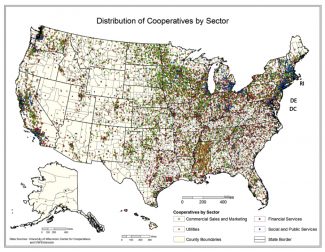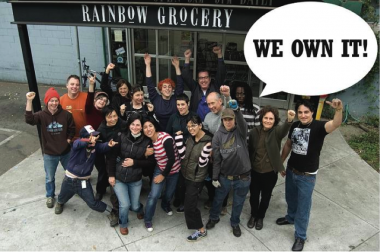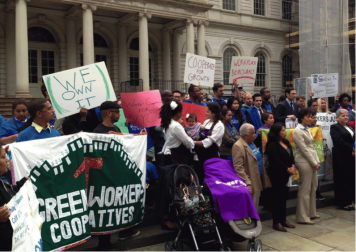Worker Cooperatives Emerging for Sustainable Development

Who will you meet?
Cities are innovating, companies are pivoting, and start-ups are growing. Like you, every urban practitioner has a remarkable story of insight and challenge from the past year.
Meet these peers and discuss the future of cities in the new Meeting of the Minds Executive Cohort Program. Replace boring virtual summits with facilitated, online, small-group discussions where you can make real connections with extraordinary, like-minded people.
Cooperative business models have gained traction as a catalyst for sustainable economic development over the past decade. The United Nations deemed 2012 the International Year of Cooperatives in order to “raise public awareness of the invaluable contributions of cooperative enterprises to poverty reduction, employment generation and social integration.”
Recently, The International Co-operative Alliance along with the International Labor Organization (ILO) have published a report on how cooperatives can help achieve the post-2015 sustainable development goals, given that cooperatives, “place emphasis on job security and improved working conditions, pay competitive wages, promote additional income through profit-sharing and distribution of dividends, and support community facilities and services such as health clinics and schools.”The benefits espoused by the ILO and UN are the direct result of how worker cooperatives are structured. In a worker co-op, the employees own the business and democratically elect the members of the board, giving rise to the principle, “one worker, one vote.” Cooperative values, as defined by the International Co-operative Alliance, are self-help, self-responsibility, democracy, equity, and solidarity. It is because of the democratic processes of worker co-ops that decision-making focuses on more than just economic return.
In the United States, spurred by the Great Recession, many cities are looking to cooperatives as an alternative way to conduct business. A study conducted by the University of Wisconsin shows that in the US, there are 30,000 cooperatives, generating over $500B in revenue. However, 340M US co-op members belong to consumer cooperatives, like REI. While consumer cooperatives have benefits such as democratic management by members, they do hold the same promise for enhanced livelihood and community investment as worker cooperatives. In the United States, there are only 5,000 worker-owners that belong to worker cooperatives, reports The Democracy Collaborative. Given that worker co-op models are best positioned to provide sustainable development, how come we aren’t seeing more in the US and how do we overcome those challenges?
Project Equity is a non-profit based in the San Francisco Bay Area that works to build economic resiliency in low-income communities through cooperatives. When asked why we don’t see more worker cooperatives in the US, co-founder Hilary Abell replied that, “1. There is a lack of familiarity with the worker co-op business model in the US, 2. Culturally, the US has a more “cowboy approach” to social entrepreneurship, and 3. Building a business is hard, many do not succeed, and worker co-ops are no exception to this rule.” However, San Francisco and New York are two cities seeing an emergence of worker cooperatives. This is mainly due to the work of non-profits and public sector programs that are supporting co-op initiatives.
San Francisco’s Bay Area, already a burgeoning region for worker cooperatives like Arizmendi Bakery and Rainbow Grocery, is seeing a new initiative emerge: The Bay Area Blueprint. A collaboration between Project Equity, the Green Collar Community Clinic, and the Sustainable Economies Law Center, The Bay Area Blueprint will forge paths to ownership for low-income workers in the East Bay. One key pillar of the Bay Area Blueprint is the Worker Coop Academy, a business and legal training course that will educate startups, traditional businesses and expanding cooperatives on how to operate worker co-ops. The Worker Coop Academy is beginning its first cohort in October of 2014. With parallel components to the tech incubator model, the Worker Coop Academy provides access to business resources and legal best practices, giving worker co-ops a better chance of surviving in the market. If the Bay Area Blueprint can effectively support the spread of worker co-op, this could mark a fundamental shift in how businesses are structured in the Bay Area.
In July, New York City Council set aside an unprecedented $1.2M of its 2015 city budget for worker cooperatives. The Worker Cooperative Business Development Initiative will “fund the efforts of a dozen organizations to create 234 jobs in worker cooperative businesses…The initiative also provides a comprehensive citywide effort to reach 920 cooperative entrepreneurs, provide for the start-up of 28 new worker cooperative small businesses, and assist another 20 existing cooperatives,” reports the New York Nonprofit Press. Similar to the Bay Area’s Worker Coop Academy, New York’s Initiative will provide technical and legal resources and in addition, financial assistance. New York’s Initiative sees worker coops as a means to increase business and asset ownership for low-wage workers and build more sustainable, resilient communities.
With the traditional business model being called into question, we are witnessing an energy building around the promise of worker cooperatives in the US. On a national level, the Creating Jobs Through Cooperatives Act was introduced to congress in 2013. The bill seeks to create a national program for cooperative development in order to create jobs and promote community development. With momentum already gained in San Francisco and New York, and building in cities like Philadelphia, Cleveland, and Houston, this pivotal point in time will test if worker cooperatives can takeoff as a way to build more sustainable and resilient cities.
Discussion
Leave your comment below, or reply to others.
Please note that this comment section is for thoughtful, on-topic discussions. Admin approval is required for all comments. Your comment may be edited if it contains grammatical errors. Low effort, self-promotional, or impolite comments will be deleted.
Read more from MeetingoftheMinds.org
Spotlighting innovations in urban sustainability and connected technology
Middle-Mile Networks: The Middleman of Internet Connectivity
The development of public, open-access middle mile infrastructure can expand internet networks closer to unserved and underserved communities while offering equal opportunity for ISPs to link cost effectively to last mile infrastructure. This strategy would connect more Americans to high-speed internet while also driving down prices by increasing competition among local ISPs.
In addition to potentially helping narrow the digital divide, middle mile infrastructure would also provide backup options for networks if one connection pathway fails, and it would help support regional economic development by connecting businesses.
Wildfire Risk Reduction: Connecting the Dots
One of the most visceral manifestations of the combined problems of urbanization and climate change are the enormous wildfires that engulf areas of the American West. Fire behavior itself is now changing. Over 120 years of well-intentioned fire suppression have created huge reserves of fuel which, when combined with warmer temperatures and drought-dried landscapes, create unstoppable fires that spread with extreme speed, jump fire-breaks, level entire towns, take lives and destroy hundreds of thousands of acres, even in landscapes that are conditioned to employ fire as part of their reproductive cycle.
ARISE-US recently held a very successful symposium, “Wildfire Risk Reduction – Connecting the Dots” for wildfire stakeholders – insurers, US Forest Service, engineers, fire awareness NGOs and others – to discuss the issues and their possible solutions. This article sets out some of the major points to emerge.
Innovating Our Way Out of Crisis
Whether deep freezes in Texas, wildfires in California, hurricanes along the Gulf Coast, or any other calamity, our innovations today will build the reliable, resilient, equitable, and prosperous grid tomorrow. Innovation, in short, combines the dream of what’s possible with the pragmatism of what’s practical. That’s the big-idea, hard-reality approach that helped transform Texas into the world’s energy powerhouse — from oil and gas to zero-emissions wind, sun, and, soon, geothermal.
It’s time to make the production and consumption of energy faster, smarter, cleaner, more resilient, and more efficient. Business leaders, political leaders, the energy sector, and savvy citizens have the power to put investment and practices in place that support a robust energy innovation ecosystem. So, saddle up.










0 Comments